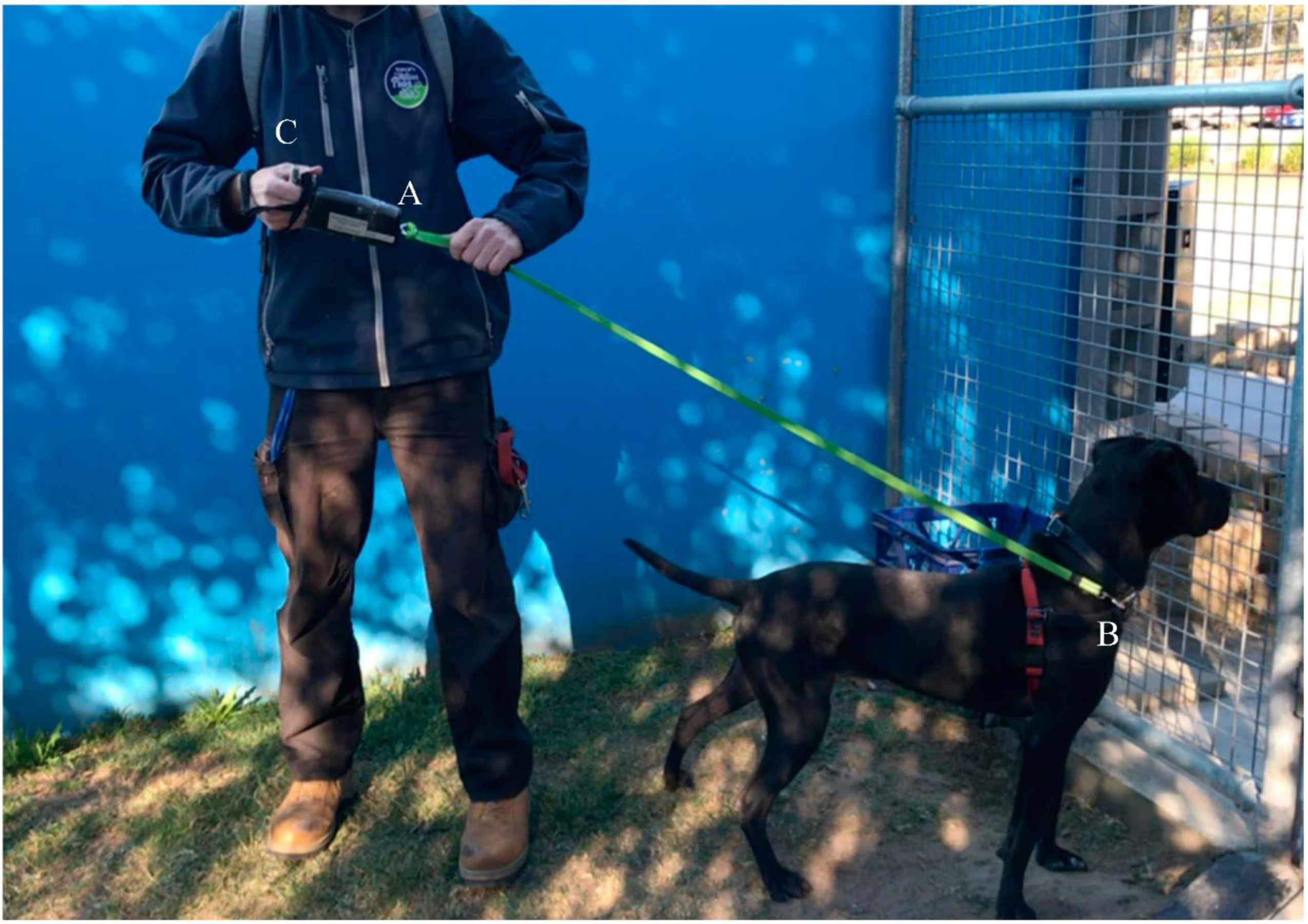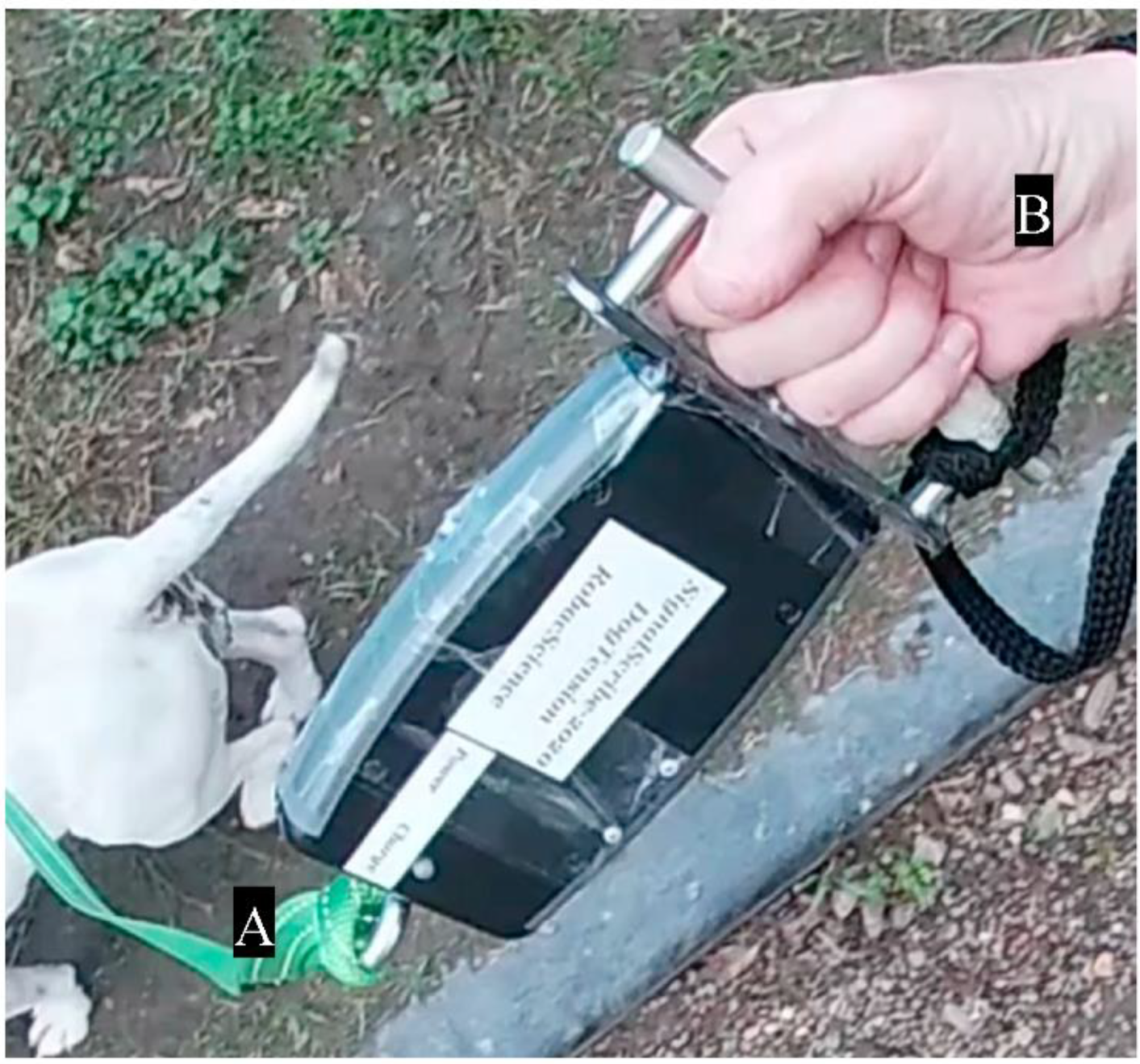Behavioural Evaluation of a Leash Tension Meter Which Measures Pull Direction and Force during Human–Dog On-Leash Walks
Simple Summary
Abstract
1. Introduction
2. Materials and Methods
2.1. Equipment
2.2. Software
2.3. Equipment Validation
2.4. Measurement of Body
2.5. Field Deployment
2.6. Data Processing
2.7. Statistical Analysis
3. Results
4. Discussion
5. Conclusions
Author Contributions
Funding
Acknowledgments
Conflicts of Interest
References
- Pauli, A.M.; Bentley, E.; Diehl, K.A.; Miller, P.E. Effects of the Application of Neck Pressure by a Collar or Harness on Intraocular Pressure in Dogs. J. Am. Anim. Hosp. Assoc. 2006, 42, 207–211. [Google Scholar] [CrossRef] [PubMed]
- Carter, A.; McNally, D.; Roshier, A. Canine collars: An investigation of collar type and the forces applied to a simulated neck model. Vet. Rec. 2020. [Google Scholar] [CrossRef] [PubMed]
- Dumbell, L.; Lemon, C.; Williams, J. A systematic literature review to evaluate the tools and methods used to measure rein tension. J. Vet. Behav. 2019, 29, 77–87. [Google Scholar] [CrossRef]
- Warren-Smith, A.K.; Curtis, R.A.; Greetham, L.; McGreevy, P.D. Rein contact between horse and handler duringspecific equitation movements. Appl. Anim. Behav. Sci. 2007, 108, 157–169. [Google Scholar] [CrossRef]
- Clayton, H.M.; Singleton, W.H.; Cloud, G.L. Measurement of rein tension during horsebcak riding using strain gage transducers. Exp. Tech. 2003, 27, 34–36. [Google Scholar] [CrossRef]
- Smith, K.K.; Hylander, W.L. Strain gauge measurement of mesokinetic movement in the lizard Varanus exanthematicus. J. Exp. Biol. 1985, 114, 53–70. [Google Scholar] [PubMed]
- Clayton, H.M.; Singleton, W.H.; Lanovaz, J.L.; Cloud, G.L. Strain gauge measurement of rein tension during riding: A pilot study. Equine Comp. Exerc. Physiol. 2005, 2, 203–205. [Google Scholar] [CrossRef]
- Eisersiö, M. How to Build a Rein Tension Meter; Swedish University of Agricultural Sciences: Uppsala, Sweden, 2013; Available online: https://stud.epsilon.slu.se/5719/7/eisersio_m_130614.pdf (accessed on 8 August 2020).
- Tatler, J.; Cassey, P.; Prowse, T.A.A. High accuracy at low frequency: Detailed behavioural classification from accelerometer data. J. Exp. Biol. 2018, 221, jeb184085. [Google Scholar] [CrossRef] [PubMed]
- Cade, D.E.; Barr, K.R.; Calambokidis, J.; Friedlaender, A.S.; Goldbogen, J.A. Determining forward speed from accelerometer jiggle in aquatic environments. J. Exp. Biol. 2018, 221, jeb170449. [Google Scholar] [CrossRef] [PubMed]
- Kubinyi, E.; Turcsán, B.; Miklósi, Á. Dog and owner demographic characteristics and dog personality trait associations. Behav. Process. 2009, 81, 392–401. [Google Scholar] [CrossRef] [PubMed]
- Voss, K.; Wiestner, T.; Galeandro, L.; Hässig, M.; Montavon, P.M. Effect of dog breed and body conformation on vertical ground reaction forces, impulses, and stance times. Vet. Comp. Orthop. Traumatol. 2011, 24, 106–112. [Google Scholar] [CrossRef] [PubMed]
- Laflamme, D. Development and validation of a body condition score system for dogs: A clinical tool. Canine Pract. 1997, 22, 10–15. [Google Scholar]
- Royal Society for the Prevention of Cruelty to Animals South Australia. Available online: https://www.rspcasa.org.au/best-walking-harness-dogs/ (accessed on 21 July 2020).
- Zuur, A.F.; Ieno, E.N.; Elphick, C.S. A protocol for data exploration to avoid common statistical problems. Methods Ecol. Evol. 2010, 1, 3–14. [Google Scholar] [CrossRef]
- Stone, H.R.; McGreevy, P.D.; Starling, M.J.; Forkman, B. Associations between Domestic-Dog Morphology and Behaviour Scores in the Dog Mentality Assessment. PLoS ONE 2016, 11, e0149403. [Google Scholar] [CrossRef] [PubMed]
- Byström, A.; Stalfelt, A.; Egenvall, A.; Von Peinen, K.; Morgan, K.; Roepstorff, L. Influence of girth strap placement and panel flocking material on the saddle pressure pattern during riding of horses. Equine Vet. J. Suppl. 2010, 38, 502–509. [Google Scholar] [CrossRef]
- van Haaften, K.A.; Grigg, E.K.; Kolus, C.; Hart, L.; Kogan, L.R. A survey of dog owners’ perceptions on the use of psychoactive medications and alternatives for the treatment of canine behavior problems. J. Vet. Behav. 2020, 35, 27–33. [Google Scholar] [CrossRef]


| Log 10 NTmax | Log 10 NTmean | Log 10 DTmax | Log 10 DTmean | Log 10 DPF 1 | Log 10 HTmax | Log 10 HTmean | Log 10 HPF 1 | |
|---|---|---|---|---|---|---|---|---|
| Dog size 2 | β 6.0 × 10−7 SE 2.0 × 10−7 p < 0.001 | β 1.0 × 10−7 SE 1.0 × 10−7 p 0.27 | β 6.2 × 10−7 SE 2.0 × 10−7 p 0.001 | β 3.8 × 10−7 SE 1.3 × 10−7 p 0.0034 | β −1.0 × 10−6 SE 3 × 10−7 p 0.018 | β 2.3 × 10−7 SE 2 × 10−7 p 0.20 | β 2.9 × 10−7 SE 1.3 × 10−7 p 0.028 | β −9.0 × 10−7 SE 3 × 10−7 p 0.001 |
| Dog age | β −1.0 × 10−3 SE 1.3 × 10−3 p 0.44 | β −2.9 × 10−4 SE 9.2 × 10−4 p 0.75 | β –9.2 × 10−4 SE 1.5 × 10−3 p 0.54 | β 3.5 × 10−4 SE 1.0 × 10−3 p 0.97 | β –6.7 × 10−3 SE 2.3 × 10−3 p 0.0034 | β −5.8 × 10−4 SE 1.4 × 10−3 p 0.68 | β −7.4 × 10−5 SE 1.0 × 10−3 p 0.94 | β −4.7 × 10−3 SE 2.1 × 10−3 p 0.027 |
| Walking Level 3 | ||||||||
| Level 1 | μ, SD 2.76, 1.09 β −0.032 SE 0.17 p 0.85 | μ, SD 0.51, 0.22 β −0.041 SE 0.13 p 0.74 | μ, SD 2.61, 1.56 β −0.021 SE 0.18 p 0.91 | μ, SD 1.03, 0.36 β 0.067 SE 0.12 p 0.59 | μ, SD 0.08, 0.05 β −0.22 SE 0.27 p 0.41 | μ, SD 2.28, 0.84 β −0.025 SE 0.18 p 0.89 | μ, SD 0.94, 0.31 β −0.054 SE 0.13 p 0.67 | μ, SD 0.09, 0.07 β −0.39 SE 0.25 p 0.11 |
| Level 2 | μ, SD 3.38, 1.9 β −0.17 SE 0.070 p 0.014 | μ, SD 0.54, 0.23 β −0.11 SE 0.058 p 0.067 | μ, SD 2.93, 1.67 β −0.16 SE 0.076 p 0.036 | μ, SD 1.07, 0.46 β −0.12 SE 0.053 p 0.021 | μ, SD 0.17, 0.14 β −0.0029 SE 0.11 p 0.98 | μ, SD 2.75, 1.55 β −0.14 SE 0.074 p 0.056 | μ, SD 1.04, 0.44 β −0.096 SE 0.053 p 0.072 | μ, SD 0.17, 0.13 β −0.14 SE 0.10 p 0.16 |
| Level 3 | μ, SD 4, 2.01 | μ, SD 0.62 0.26 | μ, SD 3.53, 1.93 | μ, SD 1.22, 0.51 | μ, SD 0.21, 0.14 | μ, SD 3.26, 1.82 | μ, SD 1.22, 0.55 | μ, SD 0.2, 0.13 |
| Level 3+ | μ, SD 4.6, 2.2 β 0.16 SE 0.16 p 0.33 | μ, SD 0.73, 0.25 β 0.11 SE 0.14 p 0.43 | μ, SD 3.87, 1.5 β 0.16 SE 0.17 p 0.36 | μ, SD 1.44, 0.46 β 0.15 SE 0.12 p 0.22 | μ, SD 0.19, 0.16 β 0.21 SE 0.24 p 0.38 | μ, SD 3.99, 2.71 β 0.18 SE 0.17 p 0.28 | μ, SD 1.31, 0.4 β 0.11 SE 0.12 p 0.38 | μ, SD 0.14, 0.09 β 0.25 SE 0.22 p 0.27 |
© 2020 by the authors. Licensee MDPI, Basel, Switzerland. This article is an open access article distributed under the terms and conditions of the Creative Commons Attribution (CC BY) license (http://creativecommons.org/licenses/by/4.0/).
Share and Cite
Shih, H.-Y.; Georgiou, F.; Curtis, R.A.; Paterson, M.B.A.; Phillips, C.J.C. Behavioural Evaluation of a Leash Tension Meter Which Measures Pull Direction and Force during Human–Dog On-Leash Walks. Animals 2020, 10, 1382. https://doi.org/10.3390/ani10081382
Shih H-Y, Georgiou F, Curtis RA, Paterson MBA, Phillips CJC. Behavioural Evaluation of a Leash Tension Meter Which Measures Pull Direction and Force during Human–Dog On-Leash Walks. Animals. 2020; 10(8):1382. https://doi.org/10.3390/ani10081382
Chicago/Turabian StyleShih, Hao-Yu, Fillipe Georgiou, Robert A. Curtis, Mandy B. A. Paterson, and Clive J. C. Phillips. 2020. "Behavioural Evaluation of a Leash Tension Meter Which Measures Pull Direction and Force during Human–Dog On-Leash Walks" Animals 10, no. 8: 1382. https://doi.org/10.3390/ani10081382
APA StyleShih, H.-Y., Georgiou, F., Curtis, R. A., Paterson, M. B. A., & Phillips, C. J. C. (2020). Behavioural Evaluation of a Leash Tension Meter Which Measures Pull Direction and Force during Human–Dog On-Leash Walks. Animals, 10(8), 1382. https://doi.org/10.3390/ani10081382






